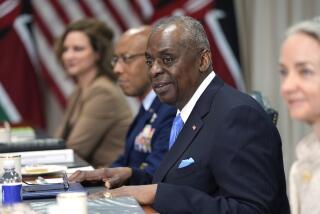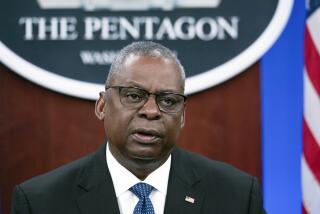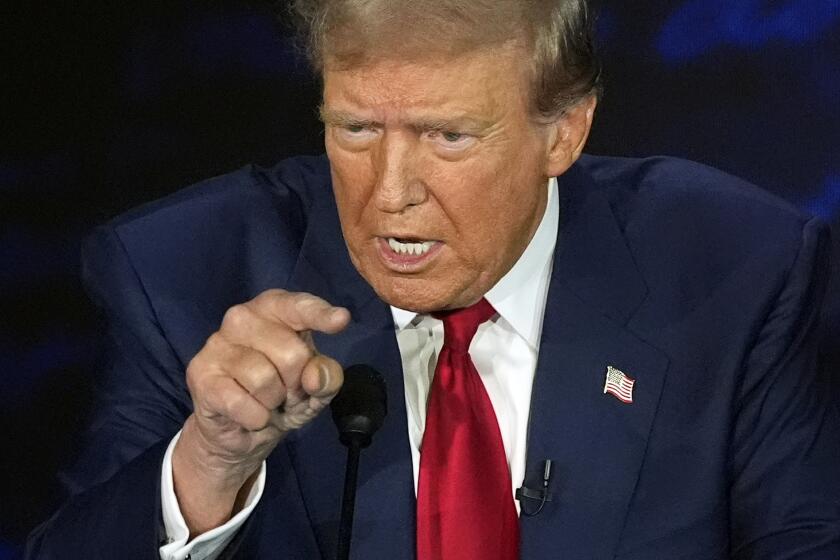After Surgery, Cheney Is Paring His High-Profile Role
- Share via
WASHINGTON — Vice President Dick Cheney returned to work Monday morning after his latest medical procedure--his spirits high, according to President Bush, and the high visibility of his role beginning to recede.
After initially working in the public eye to help formulate, direct and give public voice to the new Bush administration’s policies, Cheney now is traveling less often than his predecessors, and has a sparse public schedule.
The change coincides with a period in which Cheney’s thickest portfolio, national energy policy, suffered in public acceptance, and his cardiac problems brought new attention to his health.
Although those closest to him in the White House argue that, behind the scenes he’s every bit the player he was during the winter and spring, Cheney has slipped into a more traditional vice presidential cast less than six months into the job.
His schedule Monday gave not an inch to his latest medical procedure, the implantation of a pager-size cardioverter defibrillator on Saturday. He received an intelligence briefing at 7:10 a.m. at his residence at the Naval Observatory; he was in the White House by 8 a.m., and worked through what his senior advisor, Mary Matalin, called “a regular day.”
Cheney owned up to being “a little tender” from the surgery, but said he was not taking painkillers.
Bush saluted Cheney’s fortitude. “He looks great; his spirits are high,” Bush said during a picture-taking session. But multiple factors are working to reshape the vice president’s job.
It was a quarter of a century ago when another vice president, Nelson A. Rockefeller, was drawn back from a particularly public role, and it was Cheney, as White House chief of staff to President Ford, who had a strong hand on the reins.
No one suggests that Cheney is stepping back into the shadows unhappily. Indeed, many of those closest to him say that he was never meant to be a public spokesman for administration policy, and that his role as architect of the energy plan was thrust on him because the administration was particularly short-staffed at the time.
“He wasn’t selected to campaign. He was selected to help the president govern. He’s the consigliere to the president,” said Kenneth M. Duberstein, who was the last chief of staff in Ronald Reagan’s White House.
Matalin argues that, as others move into their jobs, they are able to pick up the pace, relieving Cheney of some of his early responsibilities. And the energy task force with which he was saddled has completed its work, she said.
Coincidence or not, the public has seen less of Cheney since late April, when he said in a major speech on energy that conservation was a “personal virtue” but did not amount to an energy policy.
“As a result of that, Cheney has had a much lower profile,” said Mark Mellman, a Democratic pollster who traces a slide in Bush’s popularity to his administration’s mid-spring focus on the nation’s energy problems.
Also, Sen. James M. Jeffords’ departure in May from the Republican Party for independent status gave Democrats control of the Senate, possibly lessening Cheney’s influence as a key administration liaison to Capitol Hill.
Cheney’s health problems have contributed to the perception that if Bush seeks a second term in 2004, he may not be on the ticket. So the vice president carries the aura, peculiar so far from the next election, of a lame duck.
But that has not necessarily weakened Cheney. His authority within the White House is boosted, some say, because this unique position means that, unlike his predecessors, he has no personal political agenda that might differ from that of the president.
“He started with the amalgam role that gave him extraordinary influence,” said Paul Light, director of governmental studies at the Brookings Institution and author of a study of the vice presidency. “He was senior counselor, chairman of the kitchen Cabinet, mentor to half the appointees, super chief of staff, and the key political advisor.
“Past vice presidents started out with virtually nothing and they gained their influence over time by proving themselves.”
Cheney’s experience, Light said, is “a vice presidency in reverse: You start out where a vice president would have ended the term, very visible. He’s moving toward a smaller and smaller role, and by the end of the year he’ll be back to a very traditional role. He started at the top, and there’s only one place to go from there.”
More to Read
Get the L.A. Times Politics newsletter
Deeply reported insights into legislation, politics and policy from Sacramento, Washington and beyond. In your inbox twice per week.
You may occasionally receive promotional content from the Los Angeles Times.










